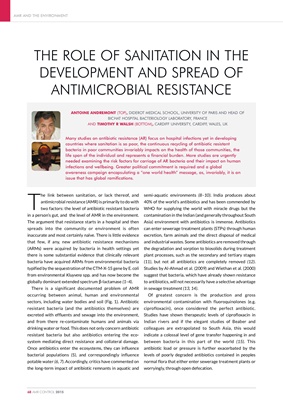
AMR AND THE ENVIRONMENT
68 AMR CONTROL 2015
T
he link between sanitation, or lack thereof, and
antimicrobial resistance (AMR) is primarily to do with
two factors: the level of antibiotic resistant bacteria
in a person's gut, and the level of AMR in the environment.
The argument that resistance starts in a hospital and then
spreads into the community or environment is often
inaccurate and most certainly naïve. There is little evidence
that few, if any, new antibiotic resistance mechanisms
(ARMs) were acquired by bacteria in health settings yet
there is some substantial evidence that clinically relevant
bacteria have acquired ARMs from environmental bacteria
typified by the sequestration of the CTM-X-15 gene by E. coli
from environmental Kluyvera spp. and has now become the
globally dominant extended spectrum β-lactamase (1-4).
There is a significant documented problem of AMR
occurring between animal, human and environmental
sectors, including water bodies and soil (Fig. 1). Antibiotic
resistant bacteria (and the antibiotics themselves) are
excreted with effluents and sewage into the environment,
and from there re-contaminate humans and animals via
drinking water or food. This does not only concern antibiotic
resistant bacteria but also antibiotics entering the ecosystem
mediating direct resistance and collateral damage.
Once antibiotics enter the ecosystems, they can influence
bacterial populations (5), and correspondingly influence
potable water (6, 7). Accordingly, critics have commented on
the long-term impact of antibiotic remnants in aquatic and
semi-aquatic environments (8-10). India produces about
40% of the world's antibiotics and has been commended by
WHO for supplying the world with miracle drugs but the
contamination in the Indian (and generally throughout South
Asia) environment with antibiotics is immense. Antibiotics
can enter sewerage treatment plants (STPs) through human
excretion, farm animals and the direct disposal of medical
and industrial wastes. Some antibiotics are removed through
the degradation and sorption to biosolids during treatment
plant processes, such as the secondary and tertiary stages
(11), but not all antibiotics are completely removed (12).
Studies by Al-Ahmad et al. (2009) and Wiethan et al. (2000)
suggest that bacteria, which have already shown resistance
to antibiotics, will not necessarily have a selective advantage
in sewage treatment (13, 14).
Of greatest concern is the production and gross
environmental contamination with fluoroquinolones (e.g.
ciprofloxacin), once considered the perfect antibiotic.
Studies have shown therapeutic levels of ciprofloxacin in
Indian rivers and if the elegant studies of Beaber and
colleagues are extrapolated to South Asia, this would
indicate a colossal level of gene transfer happening in and
between bacteria in this part of the world (15). This
antibiotic load or pressure is further exacerbated by the
levels of poorly degraded antibiotics contained in peoples
normal flora that either enter sewerage treatment plants or
worryingly, through open defecation.
THE ROLE OF SANITATION IN THE
DEVELOPMENT AND SPREAD OF
ANTIMICROBIAL RESISTENCE
ANTOINE ANDREMONT (TOP), DIDEROT MEDICAL SCHOOL, UNIVERSITY OF PARIS AND HEAD OF
BICHAT HOSPITAL BACTERIOLOGY LABORATORY, FRANCE
AND TIMOTHY R WALSH (BOTTOM), CARDIFF UNIVERSITY, CARDIFF, WALES, UK
Many studies on antibiotic resistance (AR) focus on hospital infections yet in developing
countries where sanitation is so poor, the continuous recycling of antibiotic resistant
bacteria in poor communities invariably impacts on the health of those communities, the
life span of the individual and represents a financial burden. More studies are urgently
needed examining the risk factors for carriage of AR bacteria and their impact on human
infections and wellbeing. Greater political commitment is required and a global
awareness campaign encapsulating a "one world health" message, as, invariably, it is an
issue that has global ramifications.